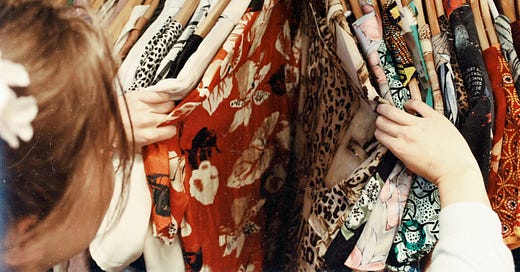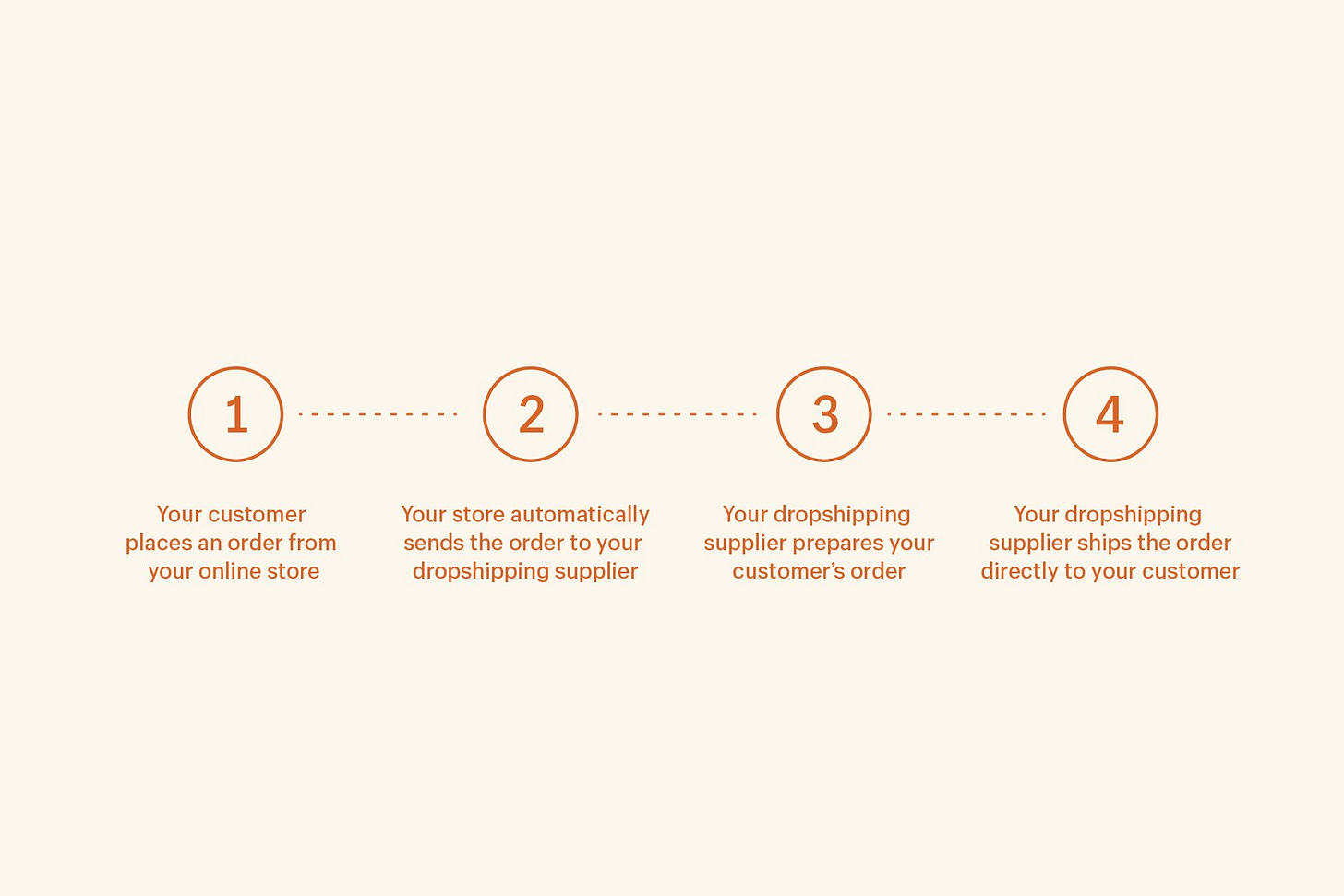📦 Your Weekly Pitch: Dropshipping delivers weirdness on demand
The seemingly convenient business model exploits online marketplaces like Etsy and Depop
Written by @KateMRedd, a journalist and extremely picky Etsy shopper
A 5 minute read
THE LEDE
For the last few months, we’ve all been locked in our own private debates: which of our pandemic habits will we keep? Which will we shed?
Online shopping is firmly here to stay. Not just on Amazon, but on sites like Etsy and Depop, which mimic the experience of a local handmade boutique or upscale thrift store without the hassle of going.
But are the sellers behind the screen really handcrafting those items, or selecting them from a donation pile? Are they packaging them into envelopes and scrawling down your address?
Or is there another method that gets all the goodwill of a handmade or secondhand purchase… without being either?
BEST PITCH TEASER
The Guiding Question:
Is dropshipping—an easy eCommerce fulfillment method that embraces the role of the middleman—more than just a convenient business model for online sellers?
The Answer:
It’s certainly more than a business model, with implications for a whole host of different sites, marketplaces, and micro-economies.
You probably already know what dropshipping is…
Even if you didn’t know it had a name. Let’s see how Shopify, the eCommerce giant, defines the practice:
“Dropshipping is a retail fulfillment method where a store doesn’t keep the products it sells in stock. Instead, when a store sells a product using the dropshipping model, it purchases the item from a third party and has it shipped directly to the customer. As a result, the seller doesn’t have to handle the product directly.”
Shopify and Amazon both embrace the practice, with information available for entrepreneurs who are interested in starting up a dropshipping business, typically powered by inexpensive products from websites like Aliexpress.
In fact, search “dropshipping” on Google or YouTube to see just how popular the practice is—it’s pushed as a get-rich-quick, work-from-home hustle by entrepreneurs and companies like eCom Babes, an online course aimed at teaching women to start successful online boutiques using dropshipping.
While dropshipping isn’t inherently a shady practice, especially if you avoid the ethical and environmental concerns of dirt-cheap retailers like Aliexpress… but it’s getting undeniably weird.
What’s so weird about dropshipping?
Start by reading Wired’s breakdown, which couldn’t do a better job addressing the hustle-culture-slash-entrepreneurship aspect: “digital nomads” selling cheap products—but also their own “wisdom” via online courses—that they’ll never put hands on. “Throwing junk at the internet and seeing what sticks,” as Wired puts it.
But where dropshipping starts to get questionable is when it’s not disclosed—when consumers think they’re getting something handmade, sustainable, or authentic, not a third-party product that the seller doesn’t even see.
Take, for example, Etsy: the online marketplace for all things handmade which, notably, does not have a publicly posted “how to dropship” policy like Amazon and Shopify. Customers turn to Etsy for all kinds of things—including a bonkers array of banned items, though that’s a separate story—and all of them are, as suggested by Etsy’s branding, advertising, and history—handmade or hand-customized.
Etsy has thrived during the pandemic, benefitting from the outpouring of support and encouragement for small, local businesses. So has Depop, the popular secondhand resale app, which scratched the secondhand-shopping itch for many consumers during lockdowns. Depop is one platform where the thrift-shopping economy has boomed, fueled by none other than Gen Z, trendsetters extraordinaire.
We already know that dropshippers have infiltrated Depop, using the app’s secondhand and thrift clothing economy to disguise new, cheaply, and often unethically made clothing as secondhand clothing. Depop specifically doesn’t allow dropshipped items, but the issue persists.
This exploits Depop’s small sellers, but also its consumer base, who are likely to be seeking out secondhand clothing for its environmental and ethical benefits.
To read more about the ethical fashion industry, check out this pitch from May.
News Peg
Etsy acquired Depop for 1.6 billion dollars earlier this month, securing what they call “the resale home for Gen Z customers” and capitalizing on the booming secondhand economy. With both platforms under one management, they have the potential to crack down on dropshippers—or else potentially become more vulnerable to them.
Why this story is worth pursuing
The pandemic blew eCommerce and online retail sky-high, and the convenience isn’t going away anytime soon. But it also raised visibility and popularity of small, local businesses—not to mention woman-, Black-, and Asian-owned businesses, to name a few.
When dropshippers exploit the popularity of those small, handmade businesses, they do real damage to the reputations of creators using online marketplaces to make a living, the consumers looking to make purchases with purpose, and the goodwill of those platforms as a whole.
What we don’t have answers to
Getting the numbers on dropshippers on Etsy and Depop can be tricky, since they’re unlikely to be disclosing that they are, in fact, not handmade or thrifted. While we all know to take disgruntled online reviewers with a grain of salt, the reviews can be a great place to see the experiences consumers have had with a seller.
A comment from Etsy regarding their dropshipping policy would be great here, too. This community post is a starting point, but it’s just user discussion, and their seller policy doesn’t mention anything using the keyword “dropshipping.” This is just a pitch, but take the time to do some digging on Etsy’s seeming avoidance of the issue.
Diverse sources worth interviewing
Like Wired’s story, talking to an entrepreneur who’s made money from dropshipping—especially if they’re willing to talk about doing it on Etsy and/or Depop—is a great peek behind the curtain. You shouldn’t have to dig too hard, since there are plenty of folks who want to tell someone how to make money this way. I’ll suggest eCom Babes again here, since they’re female-founded-and-focused; a rarity in the world of digital entrepreneurs.
Jill Simeone, Etsy’s Chief Legal Officer, would be the top-level insight into the company’s policies, language, and attitude surrounding dropshipping. Jessica Doyle, their Vice President of Global Communications and Engagement Marketing could likely speak to the potential damages of dropshipping to PR and goodwill, too.
PUBLICATIONS TO PITCH TO
The Cut covers all aspects of style and shopping.
The Verge is Vox’s tech and culture vertical—dropshipping and eCommerce fall right on that midpoint.
Slate adores the business and weirdness of the internet in long-form analysis.
IN CASE YOU MISSED IT
🎓 Stolen scholarships in higher education
Students accuse law schools of “section stacking” to covertly trap people into predatory scholarships
SEE YOU ON THE WIRE
Want the next great pitch before anyone else?
Want to share this pitch with another journalist who might want to run with this story?
See something we should have added/corrected/a tip for a future story? Publishing this story and want us to share?
Have ideas on how we can improve as a service for journalists?






